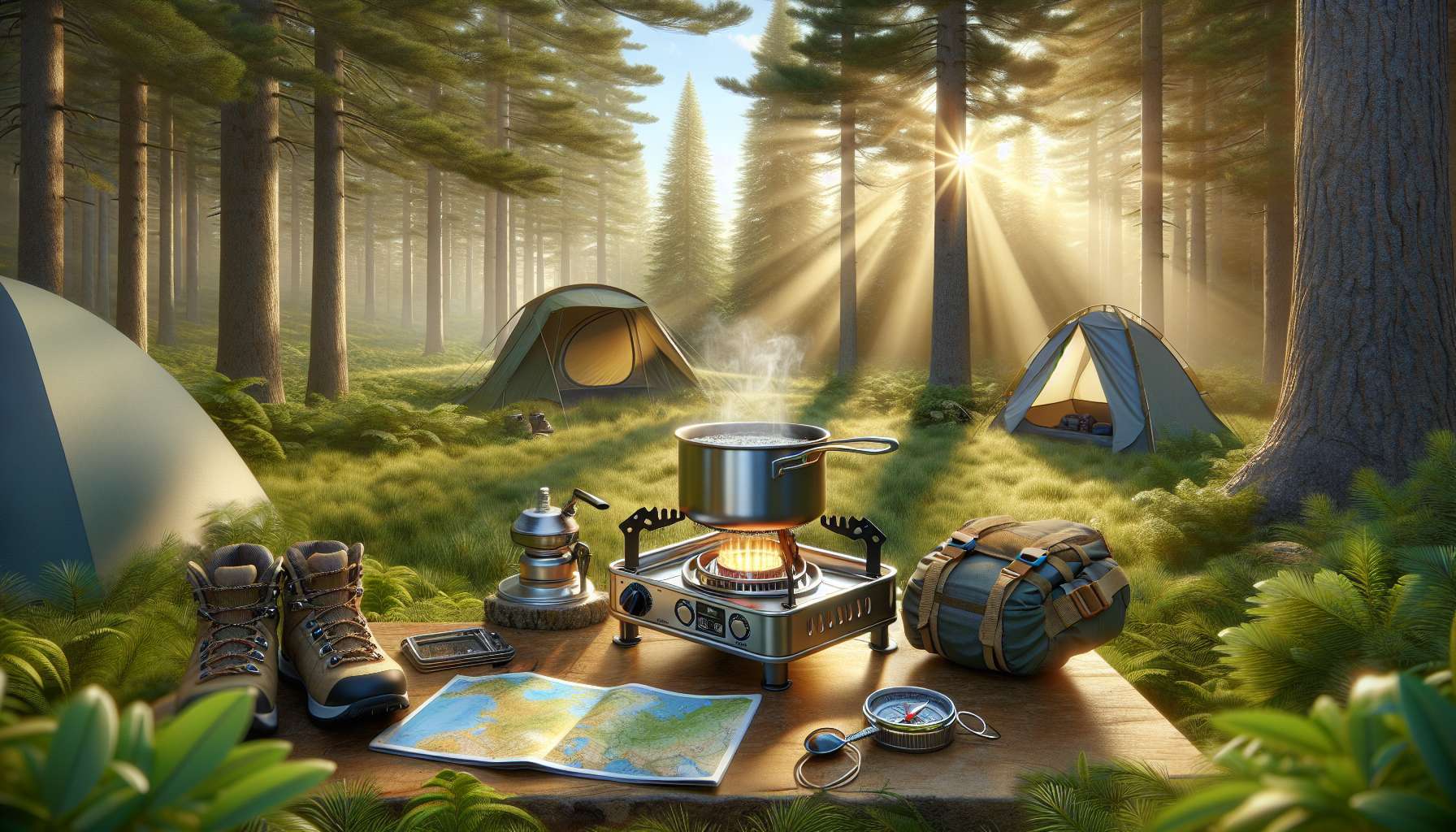Unveiling the Magic of Backpacking Stoves: A Comprehensive Guide
Embarking on a backpacking adventure often means leaving behind the comforts of home, but that doesnt mean sacrificing a hot meal or a cup of coffee in the wilderness. Enter backpacking stoves the trusty companions of outdoor enthusiasts, hikers, campers, and survivalists alike. These compact, portable devices have revolutionized the way we cook and enjoy meals in the great outdoors. In this detailed guide, we will delve into the fascinating world of backpacking stoves, exploring their history, types, features, and the essential role they play in outdoor activities.
The Evolution of Backpacking Stoves
Backpacking stoves have come a long way since their humble beginnings. The first backpacking stoves were simple, rudimentary devices that relied on wood, charcoal, or alcohol for fuel. These early stoves were bulky, heavy, and often inefficient, but they paved the way for the innovative designs we see today. Over the years, advancements in technology and materials have led to the development of lightweight, compact, and highly efficient backpacking stoves that cater to the diverse needs of outdoor enthusiasts.
One of the key milestones in the evolution of backpacking stoves was the introduction of the portable gas stove in the early 20th century. These stoves revolutionized outdoor cooking by providing a reliable, convenient, and clean-burning fuel source. Today, backpacking stoves come in a variety of fuel types, including canister stoves, liquid fuel stoves, alcohol stoves, and wood-burning stoves, each offering unique benefits and capabilities.
Types of Backpacking Stoves
When it comes to choosing a backpacking stove, there are several factors to consider, including fuel type, weight, size, and intended use. Lets explore some of the most popular types of backpacking stoves:
Canister Stoves
Canister stoves are perhaps the most popular choice among backpackers due to their convenience, ease of use, and quick setup. These stoves utilize pressurized gas canisters containing isobutane or propane as fuel. Canister stoves are lightweight, compact, and ideal for solo or small group trips. They are known for their reliability in various weather conditions and high altitudes.
Liquid Fuel Stoves
Liquid fuel stoves, such as white gas stoves, are versatile, efficient, and suitable for long expeditions and cold weather camping. These stoves run on liquid fuels like white gas, kerosene, or diesel, providing consistent performance in extreme conditions. Liquid fuel stoves are known for their ability to operate at high altitudes and low temperatures, making them a popular choice for mountaineers and winter campers.
Alcohol Stoves
Alcohol stoves are lightweight, affordable, and easy to use, making them a favorite among ultralight backpackers and minimalist adventurers. These stoves use denatured alcohol or isopropyl alcohol as fuel, which is readily available and environmentally friendly. Alcohol stoves are simple in design, with few moving parts, making them reliable and low maintenance.
Wood-Burning Stoves
Wood-burning stoves offer a sustainable and eco-friendly alternative to traditional fuel stoves. These stoves use twigs, pine cones, and other natural materials as fuel, eliminating the need to carry fuel canisters. Wood-burning stoves are ideal for extended trips where resupplying fuel may be challenging. They also provide a unique camping experience, allowing users to cook over an open flame and enjoy the sights and sounds of a crackling fire.
Solid Fuel Stoves
Solid fuel stoves, such as hexamine tablets or esbit fuel, are compact, lightweight, and easy to use. These stoves are popular among minimalist backpackers and emergency preparedness kits. Solid fuel stoves burn efficiently and leave minimal residue, making them a clean and convenient option for short trips or backup cooking solutions.
Features to Consider
When selecting a backpacking stove, its essential to consider various features that can impact performance, usability, and overall satisfaction. Here are some key features to keep in mind:
Weight and Size
One of the primary considerations when choosing a backpacking stove is its weight and size. Lightweight and compact stoves are preferred for backpacking trips, as they take up minimal space in your pack and reduce overall carrying weight. Consider the size of the stove when packed and its compatibility with your cookware and accessories.
Boil Time and Fuel Efficiency
The boil time of a stove refers to the time it takes to bring a certain amount of water to a boil. Faster boil times are desirable for quick meal preparation and fuel efficiency. Look for stoves that offer a balance between fast boil times and efficient fuel consumption to optimize your cooking experience.
Wind Resistance
Wind can significantly impact the performance of a backpacking stove by reducing heat output and increasing fuel consumption. Choose a stove with a windscreen or wind-resistant design to ensure consistent performance in windy conditions. Some stoves come with built-in wind protection, while others require separate windshields for optimal efficiency.
Simmer Control
Simmer control allows you to adjust the flame intensity for precise cooking temperatures. Stoves with simmer control are versatile and can accommodate a range of cooking styles, from boiling water to simmering sauces. Look for stoves with adjustable flame settings to tailor your cooking experience to your preferences.
Stability and Support
A stable and secure stove platform is essential for safe cooking in the backcountry. Choose a stove with a wide base, sturdy legs, and a reliable support system to prevent tipping or accidents. Some stoves come with pot supports or integrated stove systems that provide added stability for larger cookware.
Ease of Use and Maintenance
Opt for a backpacking stove that is easy to set up, light, and operate, especially after a long day of hiking. Consider stoves with push-button ignitions, foldable pot supports, and intuitive designs for hassle-free cooking. Additionally, choose a stove that is easy to clean and maintain, ensuring longevity and reliability on your outdoor adventures.
Expert Opinions
We reached out to seasoned outdoor enthusiasts and backpacking experts for their insights on choosing the right backpacking stove. According to John, an experienced hiker and backpacker, When selecting a backpacking stove, consider the fuel availability, weight, and performance based on your trip requirements. Its essential to match the stove to your intended use and cooking preferences for a seamless outdoor experience.
Sarah, a camping enthusiast and gear reviewer, recommends, Look for stoves that offer a good balance between weight, efficiency, and functionality. Think about the type of cooking youll be doing and the conditions youll encounter to determine the most suitable stove for your needs.
Common Misconceptions
There are several misconceptions surrounding backpacking stoves that can influence purchasing decisions and usage. One common misconception is that all backpacking stoves are the same, leading to overlooking key features and differences between stove types. In reality, each type of backpacking stove offers unique benefits and drawbacks that cater to different camping styles and preferences.
Another misconception is that lightweight backpacking stoves sacrifice performance for portability. While some ultralight stoves may have limitations in extreme conditions, many lightweight stoves offer impressive boil times, fuel efficiency, and stability for a wide range of outdoor activities. Its essential to research and test different stoves to find the right balance between weight and performance for your adventures.
Comparative Analysis
When comparing backpacking stoves, its crucial to evaluate key factors like fuel type, weight, boil time, wind resistance, and price to make an informed decision. Consider the following comparative analysis of popular backpacking stoves:
Canister Stove A vs. Liquid Fuel Stove B
Canister Stove A: Lightweight, compact, easy to use, suitable for solo trips, fast boil times, limited cold weather performance. Price: $50
Liquid Fuel Stove B: Versatile, efficient, stable in extreme conditions, ideal for group trips, slower boil times, higher maintenance. Price: $100
In this comparison, Canister Stove A excels in portability and convenience, making it a great choice for short trips and solo travelers. However, Liquid Fuel Stove B offers superior performance and stability in challenging environments, making it a reliable option for extended expeditions and group outings. Consider your specific needs and preferences to determine the most suitable stove for your adventures.
FAQs
Q: What is the best fuel type for backpacking stoves?
A: The best fuel type for a backpacking stove depends on your trip duration, weather conditions, and cooking style. Canister stoves are popular for their convenience, while liquid fuel stoves offer versatility and performance in extreme environments.
Q: How do I maintain my backpacking stove?
A: To maintain your backpacking stove, regularly clean the burner, inspect fuel lines for leaks, and store it in a dry, ventilated area when not in use. Follow the manufacturers guidelines for proper maintenance and troubleshooting.
Q: Can I use different fuel types in the same stove?
A: It is not recommended to mix fuel types in the same stove, as it can lead to clogs, leaks, and safety hazards. Always use the specified fuel type recommended by the manufacturer for optimal performance and safety.
To Wrap Things Up
Backpacking stoves are essential tools for outdoor enthusiasts looking to enjoy hot meals, drinks, and snacks on their adventures. Whether you prefer the convenience of a canister stove, the versatility of a liquid fuel stove, or the simplicity of an alcohol stove, there is a backpacking stove to suit every need and preference. By considering key features, expert opinions, and common misconceptions, you can make an informed decision when choosing a backpacking stove for your next outdoor excursion. So, pack your gear, fuel up your stove, and hit the trails to experience the magic of outdoor cooking in the wilderness!




